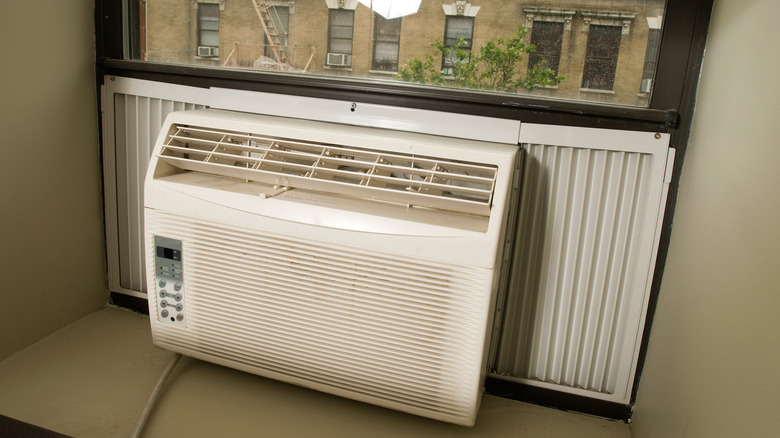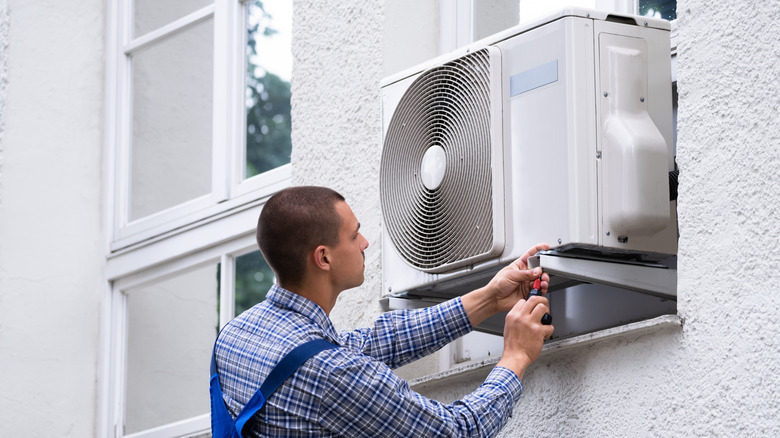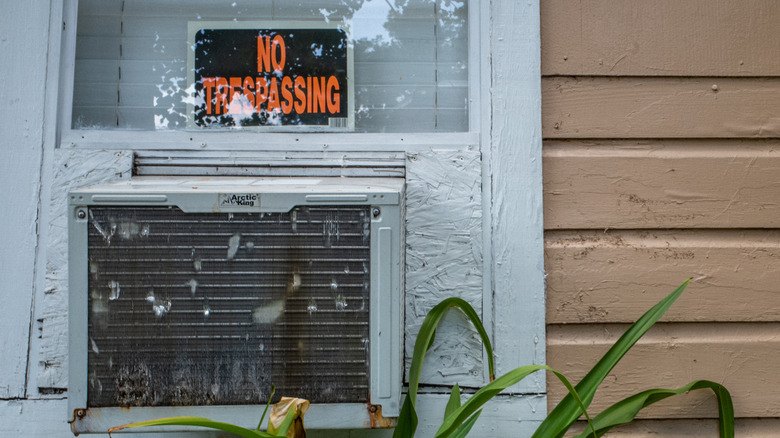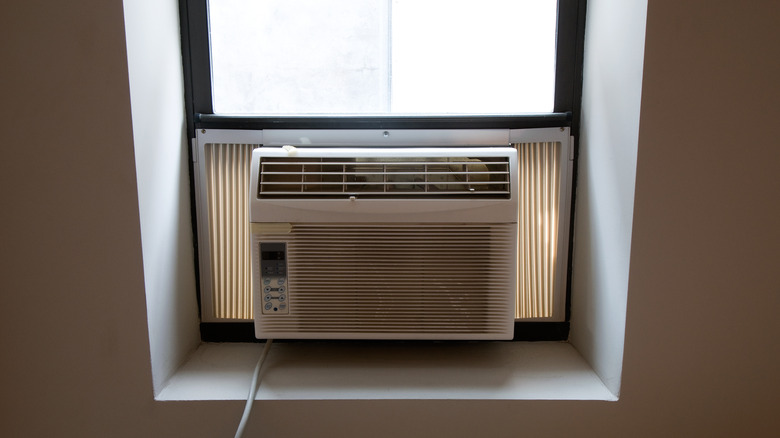The Do's And Don'ts Of Installing A Window AC Unit
There are several reasons you may be considering installing a window AC unit. Window air conditioners offer an affordable option for keeping a room cool during the hot summer months. They are not only considerably less expensive to purchase than a whole-home HVAC system, but they also cost less to run. Compared to fans and portable air conditioners, these units can also be a better option if you want to conserve floor space.
Window air conditioners can be installed in a variety of places, making them a versatile cooling product. You can add them to bedrooms, offices, apartments, and even dorm rooms. But before you jump right in and try to install an air conditioning cabinet, read through the list of do's and don'ts below. These will help you avoid hiccups during the installation process, as well as ensure that your unit functions as desired to keep your room cool.
Don't forget to measure the room and window dimensions
Choosing an appropriately sized window unit — both in terms of the physical dimensions and its ability to cool a small or large room effectively — is essential. Home Air Guides explains that you need to start by measuring the room where you plan to install the unit. This will help you to avoid picking a model that is too small to adequately cool the space or one that is larger and more expensive than necessary.
Calculate the room's square footage by multiplying the length and width together. For example, if the room is 15 feet wide and 22 feet long, it would be 330 square feet (15 x 22 = 330). After calculating the square feet, you can use that value to find the appropriate BTU (British Thermal Unit) measurement for the space. Air conditioners with a higher BTU rating are designed for larger rooms, while those with lower BTU ratings are better suited for smaller rooms. For example, a 5,000 BTU model would be sufficient for rooms between 100 and 150 square feet, but a larger 9,000 BTU model would be necessary to cool rooms of 350 to 400 square feet.
In addition to calculating how many square feet the room is, consider the size of the window where you'll place the air conditioners. The accordion side panels on each cabinet allow it to adjust to fit a variety of window sizes, but these panels will only stretch so far. You'll want to measure your window's dimensions to ensure that a particular unit will fit in it properly.
Do look for Energy Star certified units
By cooling a few individual rooms rather than the entire home, window AC units can help you reduce energy costs compared to a whole-home HVAC unit. However, that doesn't mean that there aren't some models that are even more efficient than others. According to The Department of Energy, their efficiency is measured in terms of their EER (energy efficiency rating), which is calculated by comparing the BTUs with the power input, or watts. A higher EER rating indicates a more energy-efficient model.
Shopping for Energy Star-certified air conditioners can help you find the most energy-efficient models. Energy Star notes that certified room AC units require an average of 9% less energy to operate, which translates to a smaller electricity bill at the end of the season. The models that have earned the Energy Star seal of approval include clear directions and appropriate materials to create a proper seal that will minimize leaks and energy loss.
Don't forget to install a support bracket for the unit
While you'll often see window AC units installed without any supports, it isn't the best idea. HVAC How To explains that cabinets should be supported with brackets to prevent them from falling out of the window or causing damage to the window sill. Before purchasing brackets for your air conditioner, check to confirm that they are rated to support its weight.
Support brackets are relatively easy to install on your own. Always check the manufacturer's instructions, but in many cases, you'll just need a tape measure and a drill or screwdriver to complete this project. Once installed, the beam will stick out from the window sill. This offers a stable base for the air conditioner to rest on, rather than leaving the unit simply hanging out of the window. Beyond helping to prevent that unit from falling out of a window, brackets can also help lessen vibrations. With fewer vibrations, the air conditioner will operate more quietly.
Do check with your landlord or HOA before installing a window air conditioner
If you rent an apartment or house, you should confirm that your landlord doesn't have a problem with you installing a window AC unit. Consumer Reports shares that landlord approval for installation is written into many leases. Even if you are not prohibited from having one, your lease may stipulate that professional installation is necessary. In some cases, your landlord may completely prohibit it — either by you or a professional. In this event, you could consider a portable air conditioner.
If there is no mention of window units in your lease, then you should be able to install one without permission. Similarly, they shouldn't be able to make you remove one unless it damages the property or presents a safety hazard.
While homeowners don't have to answer to a landlord, some do live in communities with a homeowner's association (HOA). Sherlock Plumbing, Heating & Air points out that some HOAs prohibit residents from installing window-mounted cabinets. This could be due to community standards on noise or appearance. It is worth researching your HOA rules before spending the time, money, and effort to put in an AC only to be told that you must remove it.
Don't place a window AC unit over a fire escape
If you live in an apartment building (and have your landlord's permission to install an AC), do not place the unit in a window leading to a fire escape. According to the National Fire Escape Association, blocking a fire escape window is not only dangerous, but it is also illegal. In the tragic event of a fire, you don't want anything standing in anyone's way of safely exiting the building.
If your apartment has two windows that lead to the fire escape, you may be able to install the AC unit in one of the windows. However, you'll have to confirm that this configuration meets the legal requirement to ensure everyone's safety should there ever be a fire. First, the unused window must be adequately sized to allow a person to step through it and access the fire escape. So transom windows don't count! Second, the unit can't block the fire escape landing. There should be a minimum of 2 feet of clearance between the air conditioning unit and the railing.
Do be selective when choosing which window to use
Beyond simply avoiding fire escape windows, there are other criteria to consider when placing your air conditioner unit in a room. DoItYourself explains it's best to choose a window in the shade for much or all of the day. Too much direct sunlight can cause the cabinet to become overheated, making it work harder to cool the room. With a shady location, the AC will work more efficiently, keeping you more comfortable and reducing unnecessary energy consumption.
The ideal window will also be protected from higher winds. If one side of your home is consistently battered with strong winds, look for a window that is more shielded from the elements. Similarly, if you live near an ocean, you should take steps to protect the unit from the salt that blows in the breeze. When you're not using the model, placing a cover over it can slow down the salt's ability to corrode the steel case. A cover will also help keep saltwater out of the compressor.
Don't try to install the unit without the help of a friend
Most window AC cabinets are very heavy, which can make them difficult and potentially dangerous to install on your own. According to Gadget Review, most window air conditioners weigh between 40 and 130 pounds. Generally speaking, the higher the BTU rating, the heavier the unit will be. This is because models with a higher BTU rating require heavy-duty parts to allow them to cool larger spaces. Rather than lifting such a heavy appliance on your own, consider asking a friend or family member to help. It will allow the job to go more smoothly and minimize the risk of you dropping the cabinet on your foot, or even worse, out the window.
If you don't have anyone to help you install the air conditioner, Roberts & Denny's Removals & Storage shares a few tips on how to safely lift heavy objects. First, examine the item and ensure that you'll be able to lift it without hurting yourself. If you're confident you'll be able to manage the weight, ensure that the route to the window is clear before picking the cabinet up. Then, stand with your feet shoulder-width apart and your back straight. Squat — do not bend over — and grab onto the item. As you walk towards the window, walk slowly and aim to keep your body straight and taught to avoid hurting yourself.
Do look for a unit with an antimicrobial air filter
Air filters are a standard component of window AC units. The filters help minimize the presence of pollutants in the air, such as pollen and dust. There are two different filter types that you may find in various models: standard filters and antimicrobial filters.
When possible, try to purchase a model that includes an antimicrobial filter. It's superior at trapping bacteria and other contaminants, keeping them out of your air. Compact Appliance explains that antimicrobial filters are designed with positively-charged components. When negatively-charged bacteria and microorganisms pass through the filter, they're attracted to its positive charge and get trapped inside the tiny crevices.
Choosing an AC unit with an antimicrobial filter can help keep the air in your home cleaner and healthier. While this will benefit everyone who lives there, it will be especially beneficial for anyone who suffers from allergies or asthma. Choosing an antimicrobial filter can also help the air conditioner last longer and operate more efficiently. When the filter traps dust, dirt, and other contaminants, not only does it keep them from recirculating into your living space, but it also keeps them from building up within the cabinet. More and more buildup over the years can lead to a decreased lifespan and decreased efficiency.
Don't let your window AC unit leave your home susceptible to break-ins
Brinks Home explains that you can take a few steps when installing your air conditioner to minimize the chances of leaving your home more vulnerable to burglars. One thing they recommend is to make sure that you mount the cabinet to the window with brackets and even corner braces. In addition to keeping the unit in its place, brackets also make it more difficult to remove the air conditioner from the outside or push it out of the way. This can deter thieves looking for a quick and easy way to access your home.
Another measure you can take to protect your home is to use window locks. By placing two sliding locks along the frame of the window, it will stop individuals from being able to push the frame up higher to gain entry from above the air conditioner unit. Adding metal or plastic flaps around the sides of the cabinet can also offer an additional layer of security.
If possible, place your window unit in an upstairs room rather than on the ground floor. If this isn't an option based on your home cooling needs, try to remove the air conditioner once the weather gets cooler and you won't be using it until the following season. Adding cameras and other home security system components can also help deter criminals and help the police catch anyone who does try to break into your property.
Don't forget to insulate your unit
Without proper insulation, your window unit may decrease the overall energy efficiency of your home, particularly in the winter. If you just follow the basic installation instructions for an AC, there will likely be several tiny gaps along the cabinet's perimeter or in and around the accordion flaps. American Home Water & Air explains that while these gaps are small, they will still allow warm air to escape during the winter. This can make your home's heating system work harder to keep the room at the desired temperature.
Sealing these gaps with insulating foam will prevent the warmer air from escaping, helping to reduce drafts and giving your heater an easier time. Because the holes are so tiny, you may not be able to easily identify them just by looking around the unit. Instead, you can light a candle and slowly move it around the cabinet's edges and the accordion flaps. Any time you notice the flame flickering, it will let you know that air from outside is getting in. Take note of where each gap is, and then fill them all in using insulating foam.
Do decide if you will be removing the unit each winter
The steps shared above can help reduce how much hot air escapes during the winter. However, Consumer Reports still says removing window units for the winter is best. Any tiny gaps that remain will allow heat transfer, ultimately resulting in higher utility bills for heating your home than would otherwise be necessary. If you decide that you are going to remove your unit, drain the water before storing it. Never store the cabinet upside down or lying down, as it could cause damage to the compressor.
If removing the unit isn't possible for whatever reason, consult the use and care guide from the manufacturer. There should be some tips for caring for the unit during winter, including covering the cabinet's exterior. If this is recommended for your model, you'll want to make sure the interior has a chance to dry fully before covering it. If it is left wet, mold may form. Choose a day with low humidity, and run the fan to help dry everything out.
Don't forget to set up a dedicated circuit for the air conditioner
HVAC Boss explains that many window air conditioners will require a dedicated circuit. Larger units being used to cool generously-sized rooms will almost always need their own circuit. These models utilize higher-capacity compressors that pull more electricity to work. As a general rule of thumb, if an AC needs 7 amps or more, you should plan on hiring an electrician to add a dedicated circuit.
Even if you have a smaller room and your unit does not need more than 7 amps to operate, you will still need a dedicated circuit if there are other large appliances in the same room. When too many large devices share a circuit, it can cause it to overheat or flip the breaker. Moreover, some building codes may specify whether dedicated circuits are required for window models, so check your local regulations.
Failing to hire an electrician to install a circuit can have serious consequences. If it becomes overloaded, the lights may flicker or even flip the breaker and cut off power to several outlets in the home. You are also increasing the risk of an electrical fire. Too much heat could also spark flames if the breaker malfunctions and doesn't flip as it should. Similarly, if the circuit gets too hot, it could cause the wiring to melt and catch on fire.












